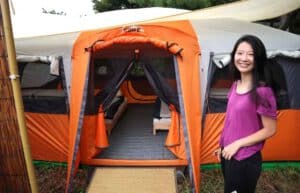GoEco > Asia > Japan > Wildlife Conservation and Cultural Immersion > Wildlife Conservation and Cultural Immersion – Images

Volunteer for wildlife and heritage conservation on one of Japan’s most beautiful Islands. Join a hands-on project that combines environmental conservation with the preservation of cultural heritage in a unique and serene setting.
Program Highlights:
Your Weekly Schedule at a Glance (minimum one week commitment):
Friday, arrival in Tokyo: A program coordinator will greet you upon arrival at the airport and accompany you to a shared house in central Tokyo. Settle in and meet other international volunteers and travelers. This will be your home for the next three days.
Saturday – Sunday, Explore Tokyo: Take this time to settle into Japan and dive into Tokyo’s vibrant culture. Your shared house is ideally located for easy access to the city’s popular sites. See Travel Highlights below for optional add-on cultural excursions available during your stay. Local staff will be on hand with travel tips and guidance to ensure a smooth journey from Tokyo to Sado Island.
Monday: Embark on an independent journey to Sado Island using Japan’s efficient train, bus, and ferry system (approximately 7 hours of travel). Upon arrival at the island port, a local team member will meet and escort you to the volunteer camp. Mondays are typically set aside as travel days, giving you time to rest and acclimate.
Tuesday – Friday: The local team will give you a welcome orientation in the morning and create your volunteer schedule. Meaningful volunteer work organized in shifts between 09:00-12:00 and 14:00-17:30. Volunteers eat lunch around 12:00 and have dinner after 19:00. Departure day is normally on a Friday, according to the ferry schedule.
Saturday – Sunday: For volunteers staying beyond one week, the weekends offer a chance to relax or take part in community activities in the morning. In the afternoons, you can join optional excursions to explore the beautiful island of Sado.
Staying for 2 weeks or longer? Combine this project with our English Exchange Program in Otaki Village for a diverse volunteer experience in Japan. We’ll assist with the transfers. We’ll help arrange the transfers. You can also begin your Japan adventure with our Tokyo to Osaka 13-Day Cultural Discovery Tour.






What’s Included





What’s not Included

Sado Island is Japan’s 6th largest island and on the list to become a UNESCO heritage site. It has a dynamic landscape of dramatic ocean cliffs, dense forests, rice fields and crystal clear water. When they found gold on Sado Island in 1601, the island flourished and developed a unique cultural heritage. This includes performing arts, the world-famous Taiko drumming, puppet theater and folklore festivals. Sado has hundreds of preserved Buddhist temples, Shinto shrines, and several villages from the Edo Period (1603-1867)

This unique volunteer program works in partnership with the local government of Sado since 2019. The goals of the program are to:
Conservation of the Crested Ibis
The Crested Ibis (“Nipponia nippon”) is a remarkable bird that was once common in Japan and China. Yet, their populations declined because of the loss of natural habitats and industrial agriculture. There were only 5 wild ibises left in Japan in 1981. The bird was declared “extinct in the wild”. They were captures to be bred in captivity. In 2008, the first Ibises of this program were released into the wild. They brought crested Ibises from China and bred them in captivity for release. They observed the first hatchings in the wild in 2012, and today there are around 500 ibises on Sado Island and mainland Japan.
Several environmental organizations, which often cooperate with Japanese universities, are active on Sado Island. You can regularly take part in various activities of these organizations. This includes monitoring Crested Ibises, finding nests and counting eggs, working on biotopes, as well as preparing and conducting environmental events and campaigns. In addition, we regularly visit sites of biological or geological interest in Sado, such as the public Crested Ibis Breeding and Research Center.
Preservation of Ogura Rice Fields
They built and cultivated the Ogura rice fields on steep slopes during the 17th century. Today, the traditionally managed terraced rice fields are not only an attractive site for visitors to Sado, but they also prevent landslides and are feeding grounds to the Crested Ibis. You can join the farmers on most weekends. They plant rice in April and harvest it in October. During other months, volunteers help maintain an ancient irrigation system. This includes fortifying the rim of the paddy fields with soils to prevent the water from flowing.
Preservation of the Chokokuji temple
Chokokuji is one of the largest and culturally most significant temples on Sado Island. It is still actively run for religious services, even though the monk is over 80 years old. The temple is said to have been founded by the Buddhist saint Kukai in the year 807. It has many cultural assets, including three eleven-headed Kannon statues declared as Nationally Important Cultural Properties, created by the saint himself. Hundreds of rabbits live on the site to keep the grass short. Volunteer assignments include maintenance work, light gardening, and activities with visiting student groups. The monk will tell volunteers interesting stories about the history of the temple and Buddhism.
Volunteers assist the monk with maintenance, cleaning, and gardening work at the temple. They also make preparations for the activities with school classes visiting the temple and run the temple’s social media marketing. With the help of volunteers, to set up a small shop in the temple, selling devotionals of Chokokuji Temple, fair trade products, and locally produced natural goods, supporting the temple and other local organizations financially.
Collecting herbs in the forest
Volunteers can help a small company collect wild herbs and leaves from the forest. You will work with local experts and learn to process herbs and leaves into tea blends.
Bamboo workshops with school children
Assist a Brazilian carpenter and artist arrange creative bamboo workshops for local schoolchildren. The children create musical instruments, toys, or playground equipment from this material. Bamboo is a fast growing sustainable material that can replace plastic in many applications. As a volunteer, the artist will teach you how to build objects from bamboo and sometimes Japanese youth groups join the handcraft workshops. You will also be able to practice English conversation with them.
Traditional farming
Local farmers in Sado Island plant and cultivate kakis, oranges, kiwis, shiitake mushrooms and bamboo. At various locations, you can help with these activities and learn about principles of agriculture and forestry in Japan.
Beach and nature cleanups
Every week, volunteers clean up a section of the beach or other natural environment. This is usually done as a competition between a few teams, and the one that collects the most trash or a certain type of trash wins a prize. During the summer, families who are camped out at Sobama Beach often take part in this.
Community Work and Cultural Immersion
Volunteers can take part in activities that benefit aging rural communities in Japan, such as restoring abandoned houses called akiyas. The countryside has seen a decrease in population, leading to many empty buildings, with some villages having up to 80-90% abandoned houses. In Matsugasaki, volunteers are helping to conserve the memory of the traditional handcraft of the last blacksmith by turning his workshop into an exhibition space. Volunteers also visit a countryside after-school club to do presentations on various topics, including their own country and environmental issues. The program regularly offers workshops and presentations on traditional local culture, such as playing the noh flute, taiko drumming, and kyogen theater play.




On Sado Island, the volunteer base is at the stunning Chokokuji Temple. You will stay in a large, fully furnished tent in the temple’s garden. The tents can be booked for single, twin, and 4-share occupancy. There are 2 showers with hot and cold water, exclusively for the use of our volunteers, and toilets at the temple. There are indoor and outdoor communal areas for sitting, taking meals, and as a workspace. For your convenience, we provide rechargeable flashlights/lanterns, sleeping bags and umbrellas in the tents. Japanese breakfast, lunch and dinner are offered in buffet-style, furthermore there are unlimited water, tea and coffee throughout the day.
*We aim to have the same gendered rooms (not always guaranteed).







During the Volunteer Program on Sado Island:
On the weekends, the local team organizes optional group activities, such as beach trips, hiking, and sightseeing, for a small extra cost. You can decide on-site if you’d like to join!
Recommended Add-On: Tokyo to Osaka 13-Day Cultural Discovery Tour
Enhance your volunteer experience by adding a guided cultural adventure before your project begins. This 13-day small-group tour travels from Tokyo to Osaka, covering major highlights such as Mt. Fuji views, a traditional tea ceremony, sushi-making, Kyoto’s temples, Hiroshima’s Peace Memorial, and an overnight onsen stay. It’s a great option for first-time visitors who want to explore Japan comfortably with local guidance.
You’ll join travelers from around the world, enjoy a mix of cultural workshops and sightseeing, and have all domestic travel arranged for you. To add this tour, please apply to both programs, and our team will handle all travel logistics to ensure a seamless experience that fits perfectly with your volunteer dates.
Availability is limited and tours start most Mondays, so early booking is recommended.

© 2022 GOECO | All rights reserved
Develop & Design | Msite